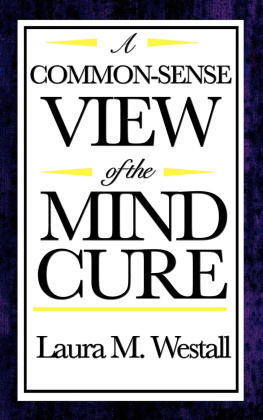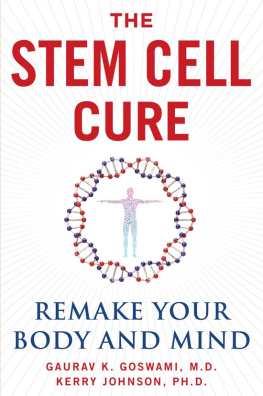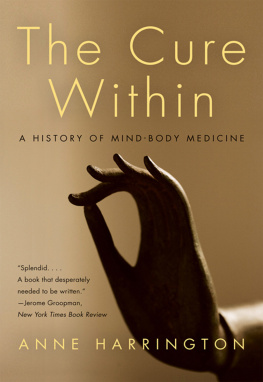A Common-Sense View of the Mind Cure
by Laura M. Westall
Start Publishing LLC
Copyright 2012 by Start Publishing LLC
All rights reserved, including the right to reproduce this book or portions thereof in any form whatsoever.
First Start Publishing eBook edition October 2012
Start Publishing is a registered trademark of Start Publishing LLC
Manufactured in the United States of America
10 9 8 7 6 5 4 3 2 1
ISBN 978-1-62558-310-9
Introduction
Out of the night that covers me,
Dark as the pit from pole to pole,
I thank whatever Gods may be
For my unconquerable soul.
It matters not how strait the gate,
How charged with punishments the scroll,
I am the master of my fate,
I am the captain of my soul!
HENLEY.
THE Western world has been slow to recognize the power of the mind over the body by reason of the fact that our philosophers from very early times regarded the mind as an independent entitya something to be considered quite apart from the body.
Mind can not move matter, they contended, because an impassable gulf exists between the two; and therefore a mental fact can not possibly be represented by a corresponding physical fact. The body, in their thought, was simply the chosen tenement of the soul, and operated independently of it. And this view in a modified form is maintained even to the present day by the adherents of the old psychology or metaphysical school.
But with the striking of the shackles from the insane by Dr. Pinel in France, with the work of Dr. Tuke in England and Dr. Rush in America, toward the latter half of the eighteenth century there sprang into being a new psychology, based upon the study of nerve-tissue and brain-action. The old psychology was speculative; the new is scientific. It has exchanged theory for the microscope.
By this method it was soon demonstrated that the brain is the organ of mind, and that the nervous system is the channel of communication between the mind and the external world, or the means by which man is put into relation with his environment.
The early phrenologists, in their attempts to localize brain function, popularized the former idea, while the brain-physiologists proved conclusively the indissoluble connection between the mind and the nervous system. Meanwhile the histologists, by their discovery of the nerve-cell and its processes, discovered the physical basis of association of ideas and memory.
Toward the middle of the nineteenth century German scientists took up the problem; and Weber, with his law of variation, Fechner, with his psychophysical law, and Wundt, by his researches in physiological psychology, demonstrated the physical basis of mind. Henceforth psychology was to be reckoned among the natural sciences.
As was to be expected, the charge of materialism has been flung at the new by the adherents of the old school. With them, to deny the independent existence of the soul was to rule God out of the universe. To affirm that mind and body are a unit is to negative the doctrine of immortality.
While admitting the justice of the criticism of those extremists who assert that thought is a function of the brain or that the brain secretes thought as the liver secretes bile, it is unjust to that large body of monists who hold that, tho mind and body must be regarded as a unit, the soul-principle is the real ego or being, and the physical organism the vehicle of its expression or embodiment. As Dr. Carus puts it, Modern psychology does not destroy the soul, but merely a false view of the ego.
Accepting the position that the brain is the immediate organ of mind, and that by means of his nervous system man gets into relation with his environment, our inquiry as to the influence which mind may exert upon matter may be conducted upon both rational and scientific lines.
The Nervous System
WITHOUT some knowledge of the nervous system, it is impossible to understand fully how the mind may affect the body.
To begin with, as every schoolboy knows, each human being has a complex system of nerves, the fountainhead of which is the brain. From the lower part of the brain, in the back of the head, issues the spinal cord, a bundle of nerve-fibers; and from this, nerves branch out and run to all parts of the body, much as branches radiate from the trunk of a tree.
But every one does not know, or else has forgotten, that we have three kinds of nervesthose that move the muscles, called motor nerves, those which receive and carry outside impressions to the brain and called sensory nerves, and those that keep up the bodily activity, keep the fires burningand these are called sympathetic.
Nervous centers are distributed throughout the body, some along the spinal column, others in the medulla oblongata. At certain places nerves unite forming a plexus,the cardiac, solar, and hypo-gastric plexuses. The solar plexus is situated just back of the stomach and the hypogastric plexus in the abdomen .
The real center of this system, says Dr. Carpenter, the English brain-physiologist, appears to lie in the medulla oblongata [the bulb at the apex of the spinal cord], and has for its function the regulation of the blood-supply to the different parts by its action on the caliber of the arteries. That is, the great blood-channels, called arteries, which carry the red blood away from the lungs, are surrounded by a branch of these sympathetic nerves (called vasomotor), which when they contract diminish the size of the channels and hence decrease the amount of blood in them. If you should bandage your arm tightly, you would get the same result; but in the case of the nerves of which we are speaking, the action is automatic and controlled from the center at the base of the brain.
Probably the reason why these nerves were first called sympathetic is that if one nerve-center is shocked or does not properly conduct itself, the others sympathize, or reflex the state of the first, and then all sorts of troubles arise.
We have an analogous experience when heavy storms ravage the country. If you call up central on the telephone, desiring to communicate with some distant town, even tho you may get central, you fail to reach your friend or business associate because of crossed wires, broken poles, etc.
The nervous system, like the telephone company, has its central stations from which lines radiate, and any little side line can get into touch with central if the intervening or allied centrals are in good running order.
So then, if there is anything wrong with the central at the base of the brain, the other centrals in the stomach or heart, for example, may become more or less unsettled and behave in a hysterical manner.
But we have said that the automatic activity of these nerves is directed from the center at the base of the brain, hence we may well ask, what directs its action?
Now we are getting down to bed-rock.
The axiom of science that no force is ever lost was noted in chapter first, and here we have an illustration of it. The force, chemical and mental, which is generated by the brain through its reaction upon the mind must go somewhere. So this force follows the nerve-fibers leading from the top of the brain down to this center of which we are speaking and quickens it into action. The center automatically reacts upon the force and sends it flashing with incredible speed down the spinal cord; and thence it follows the branching nerves in every direction to the uttermost limits of the body; what is unused by the body radiates into space .













